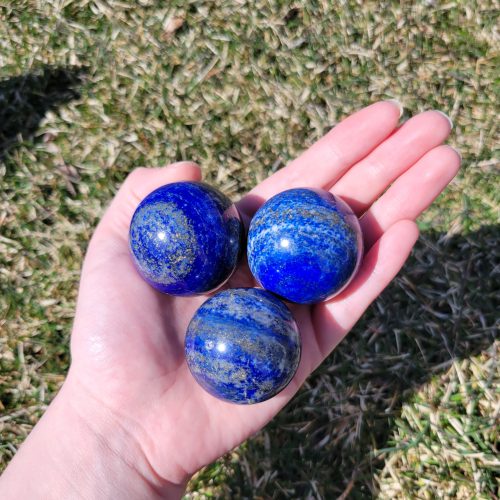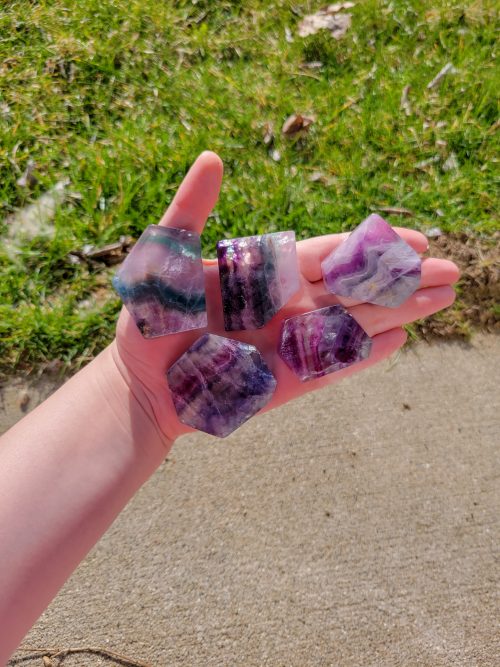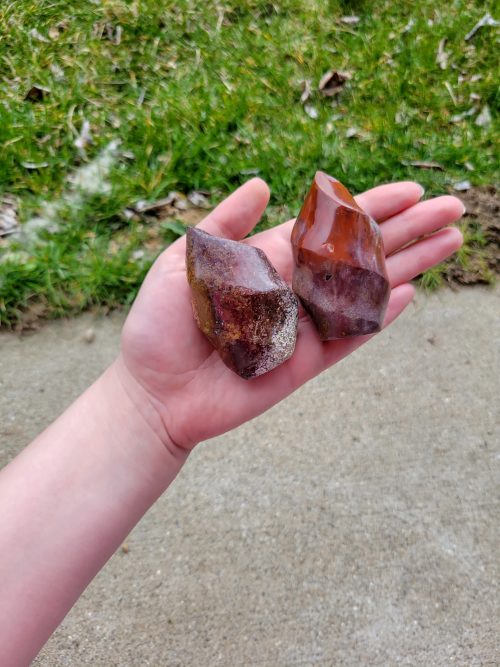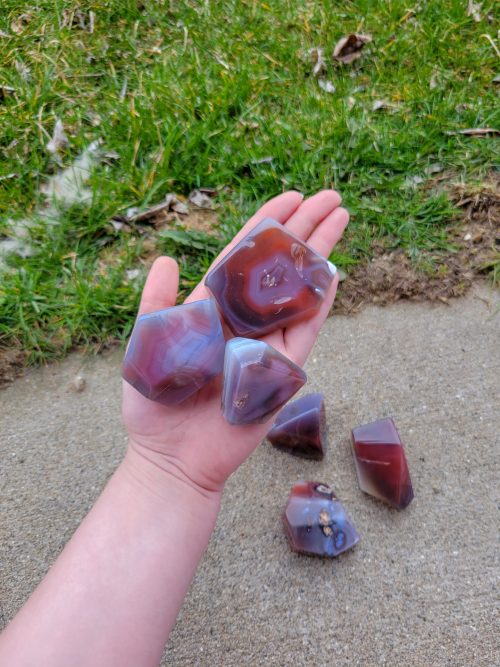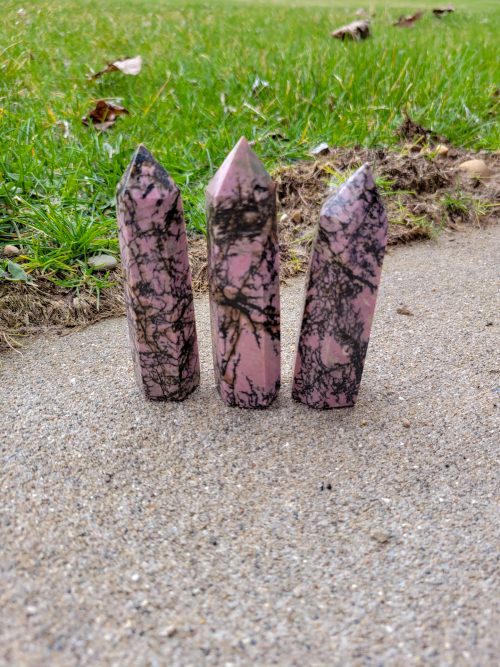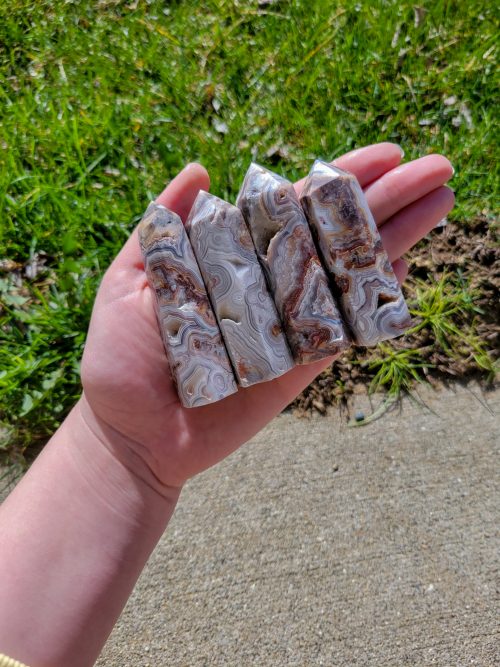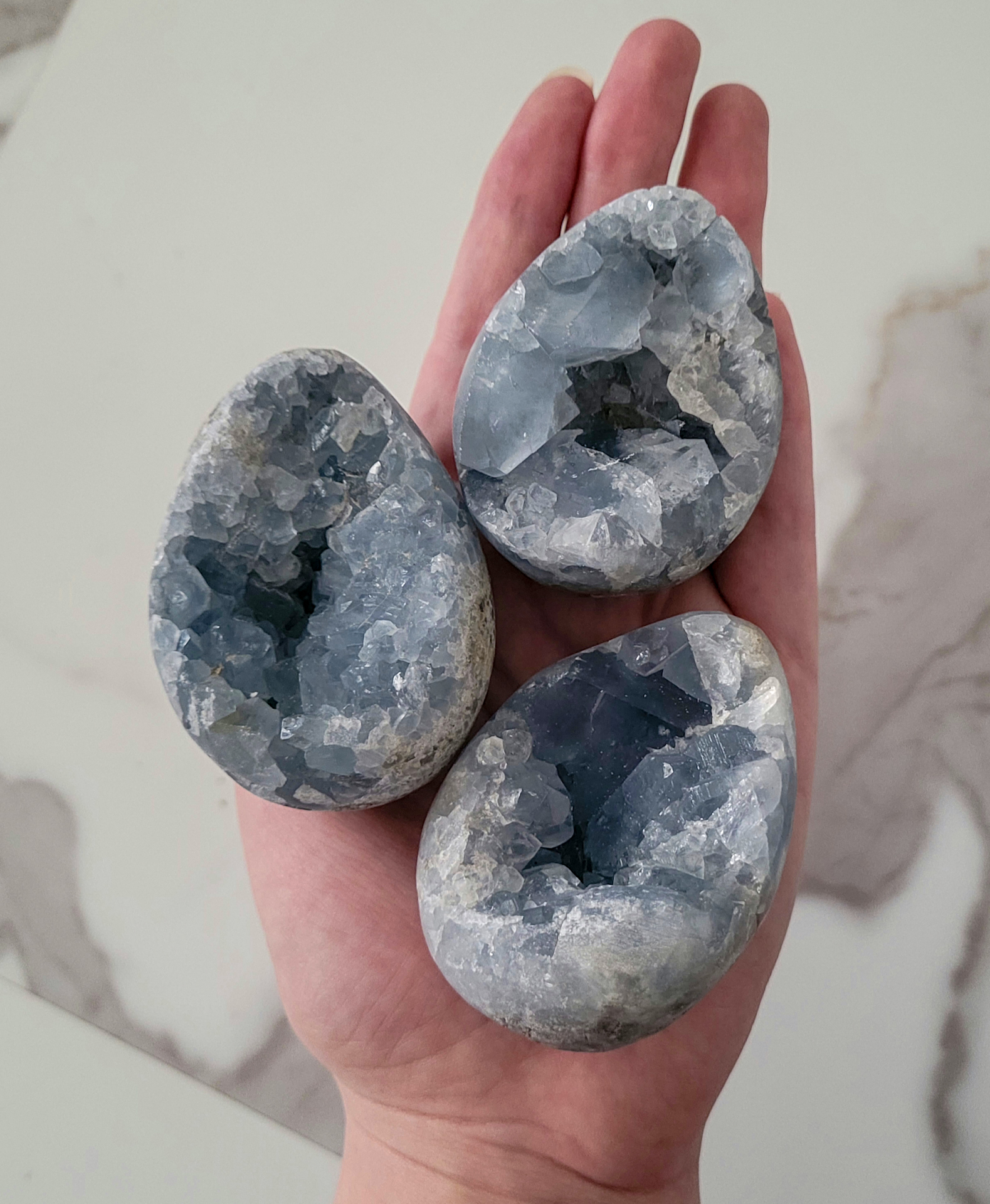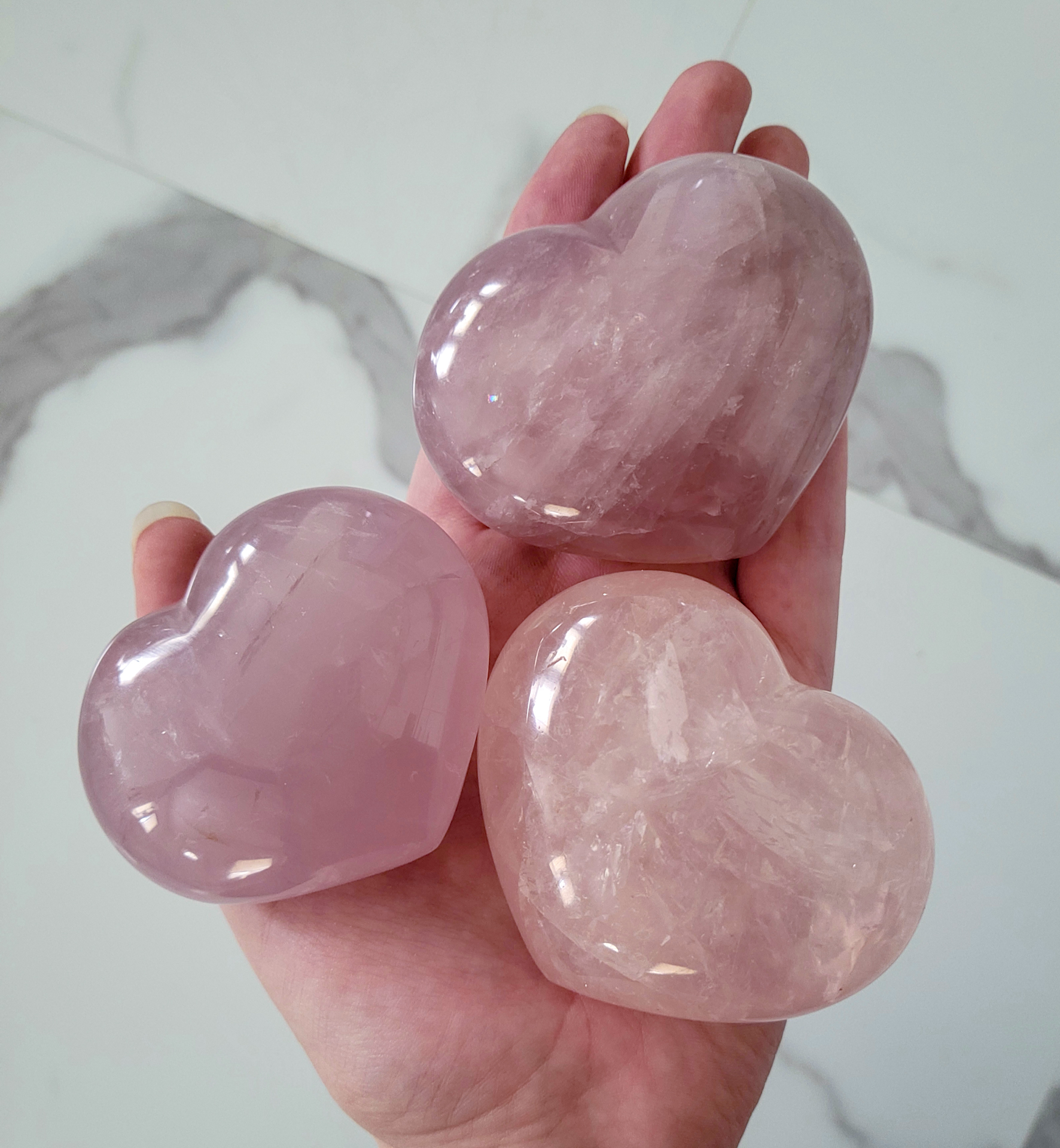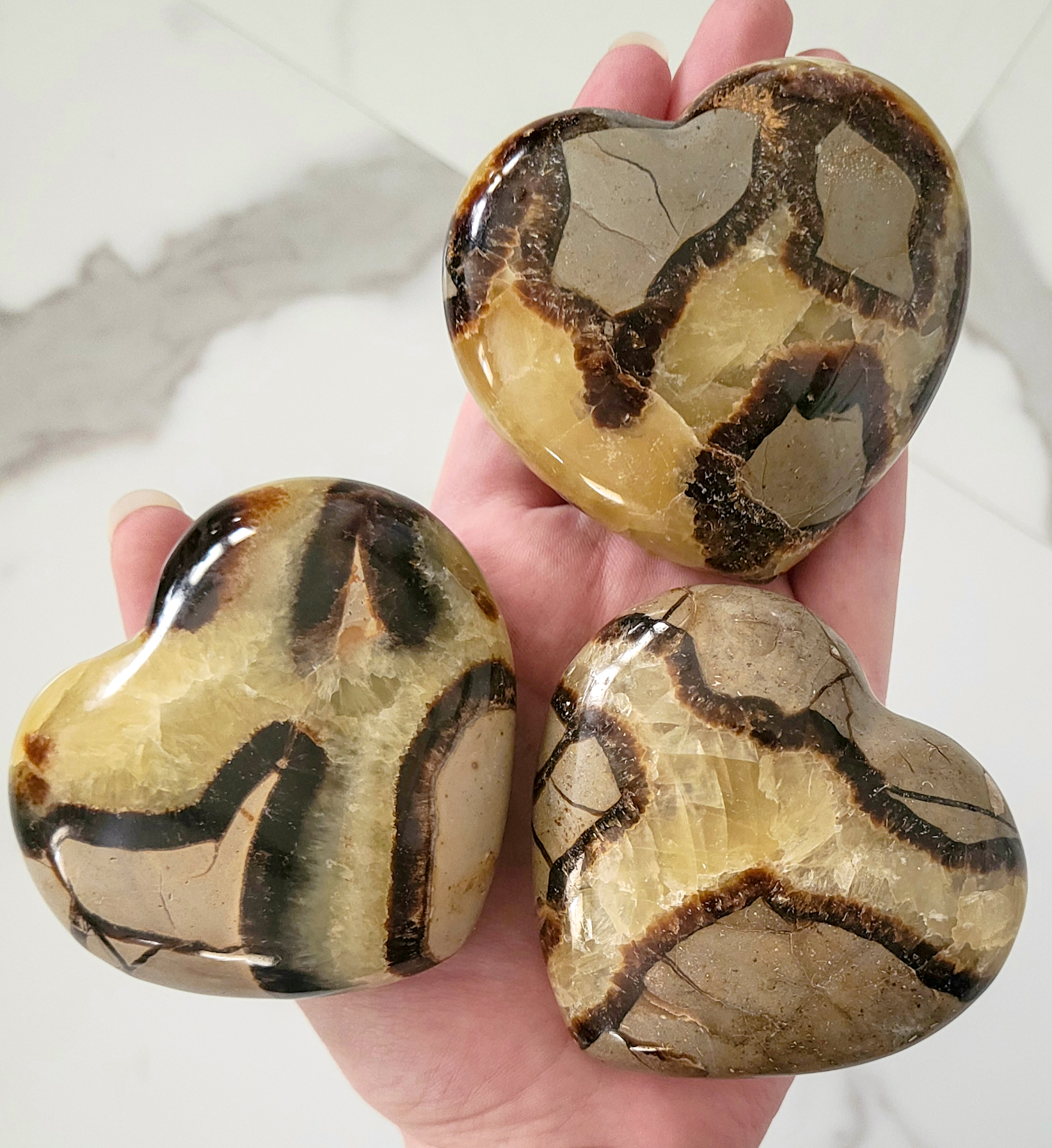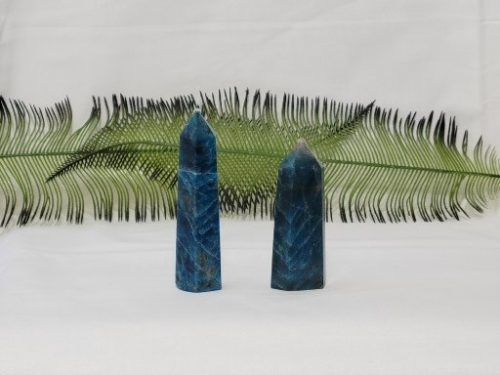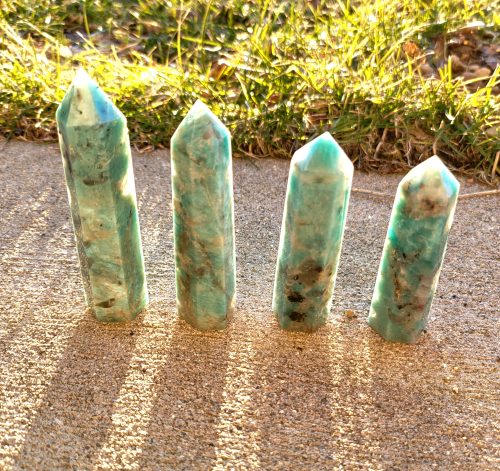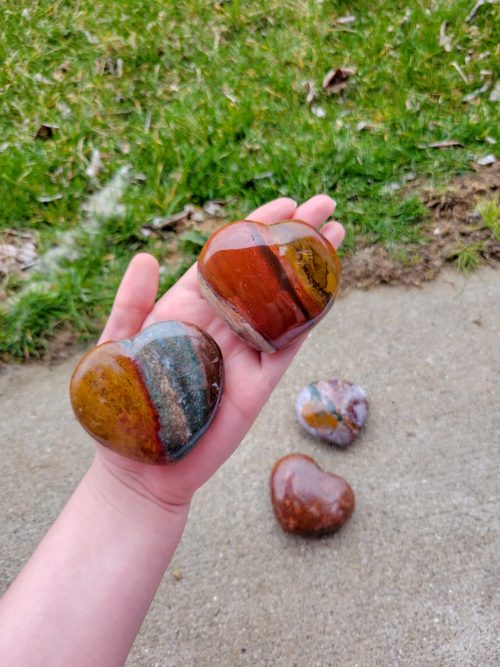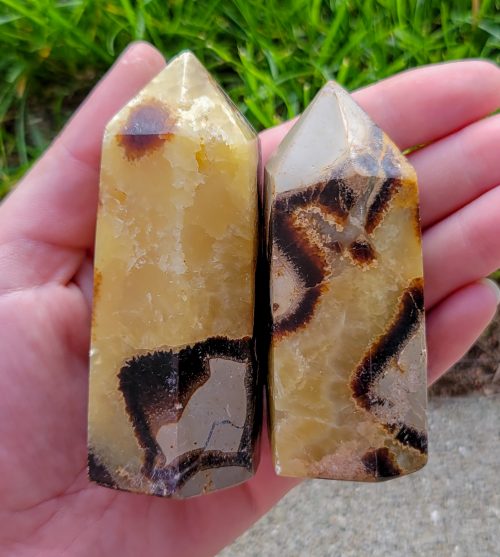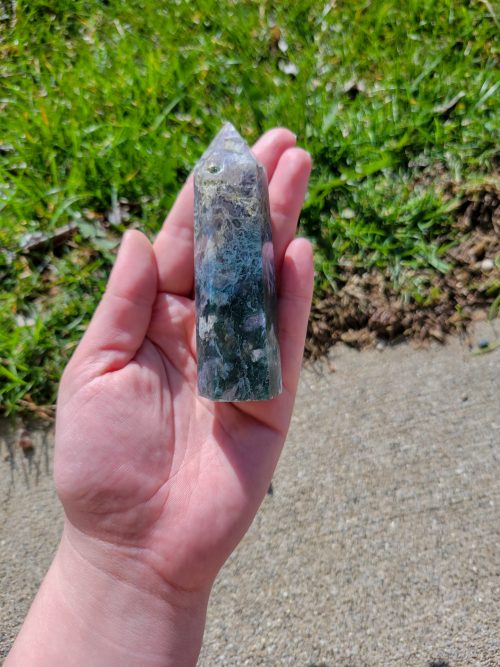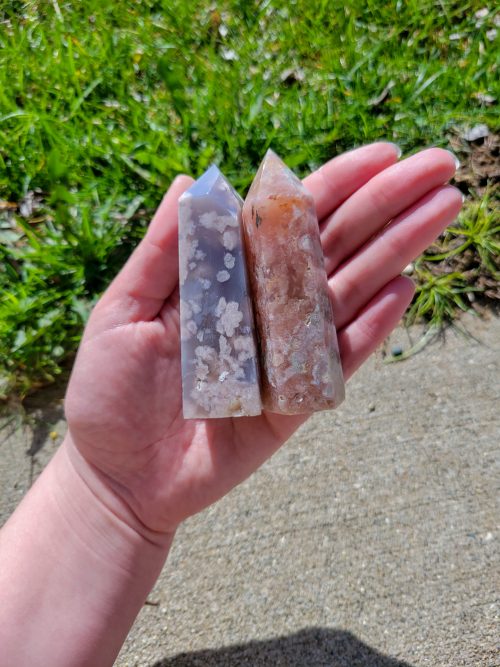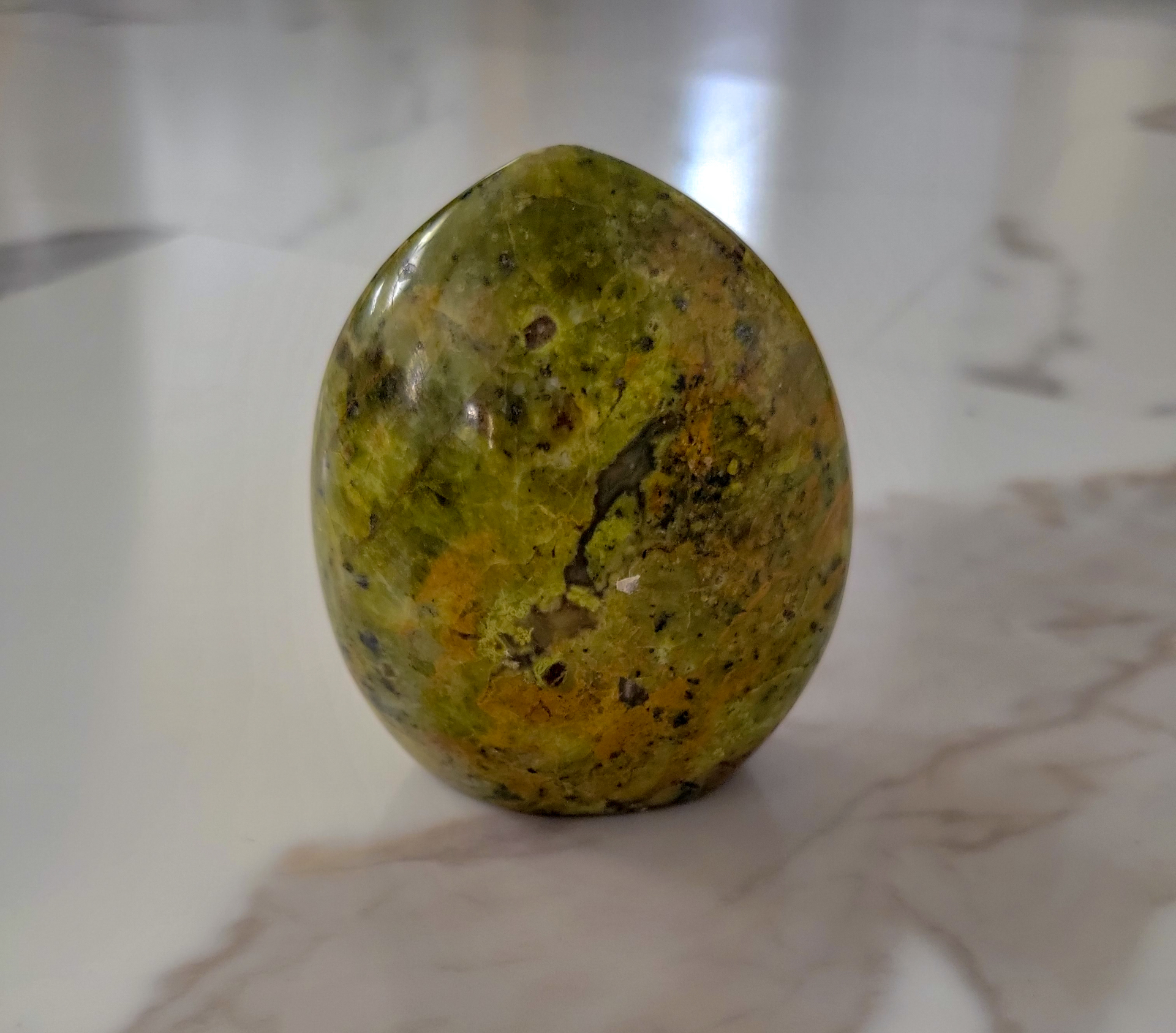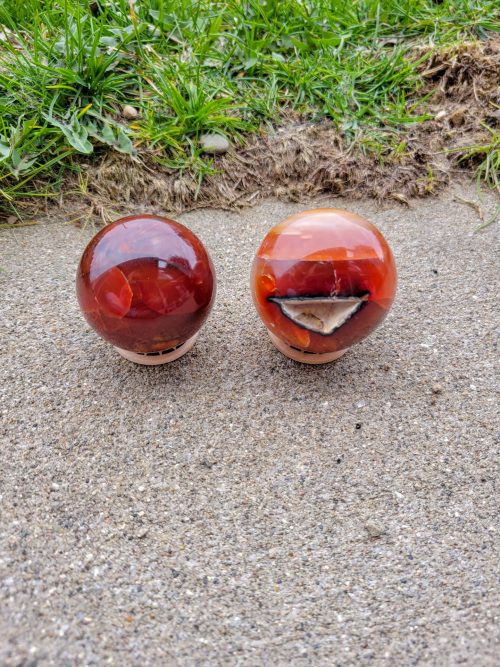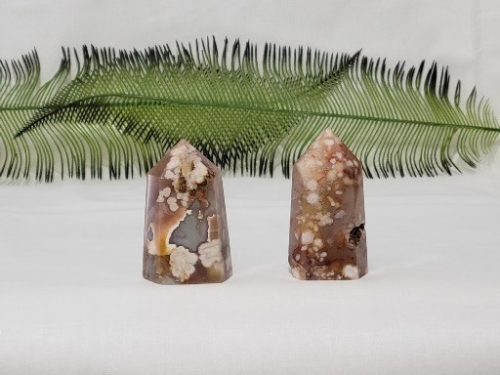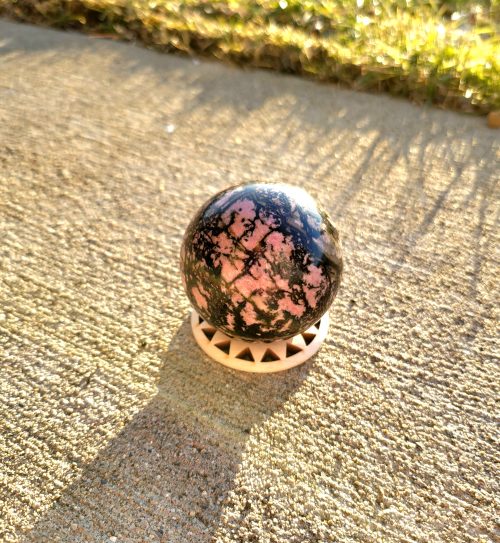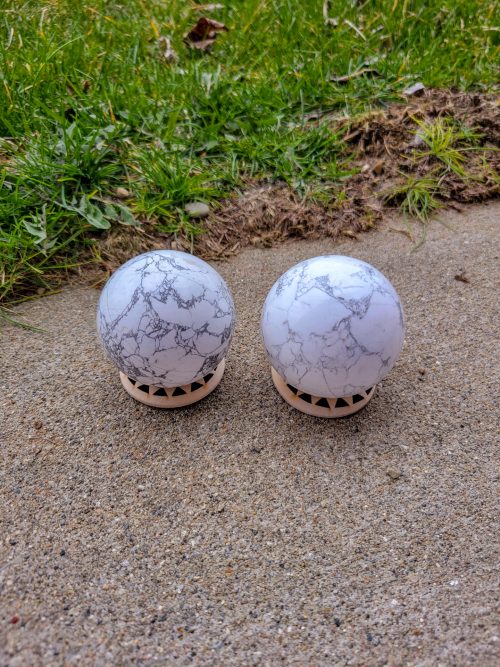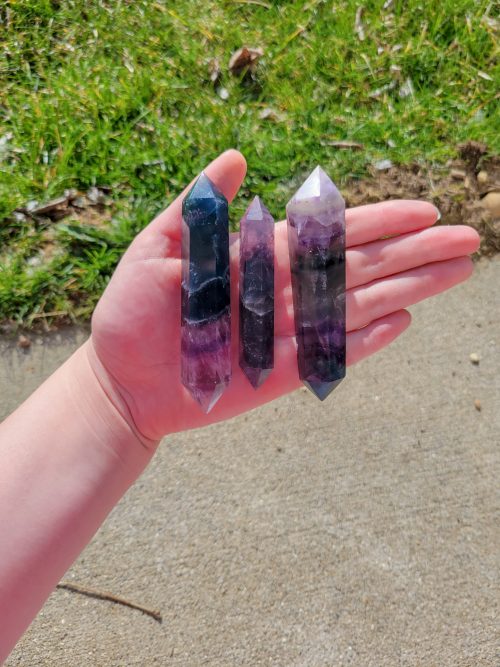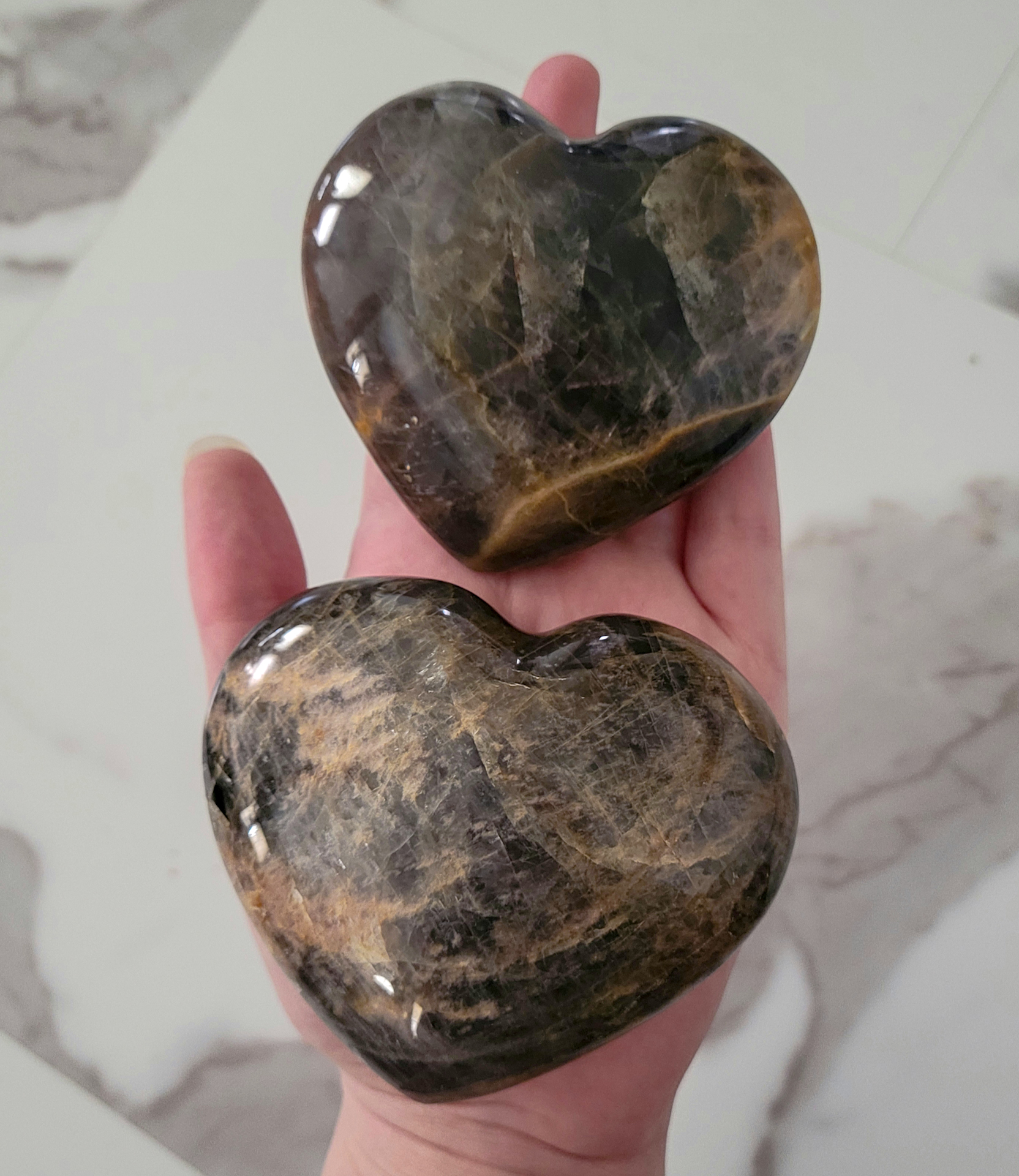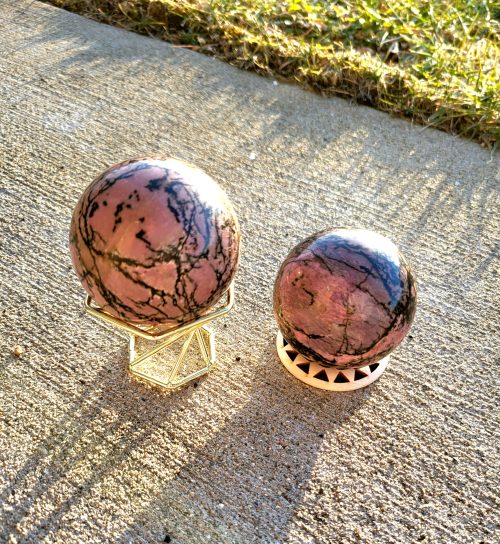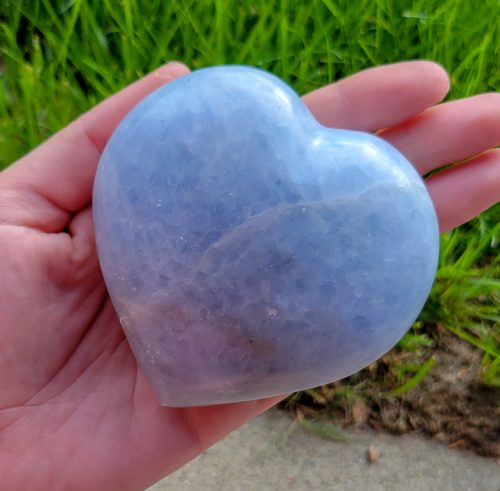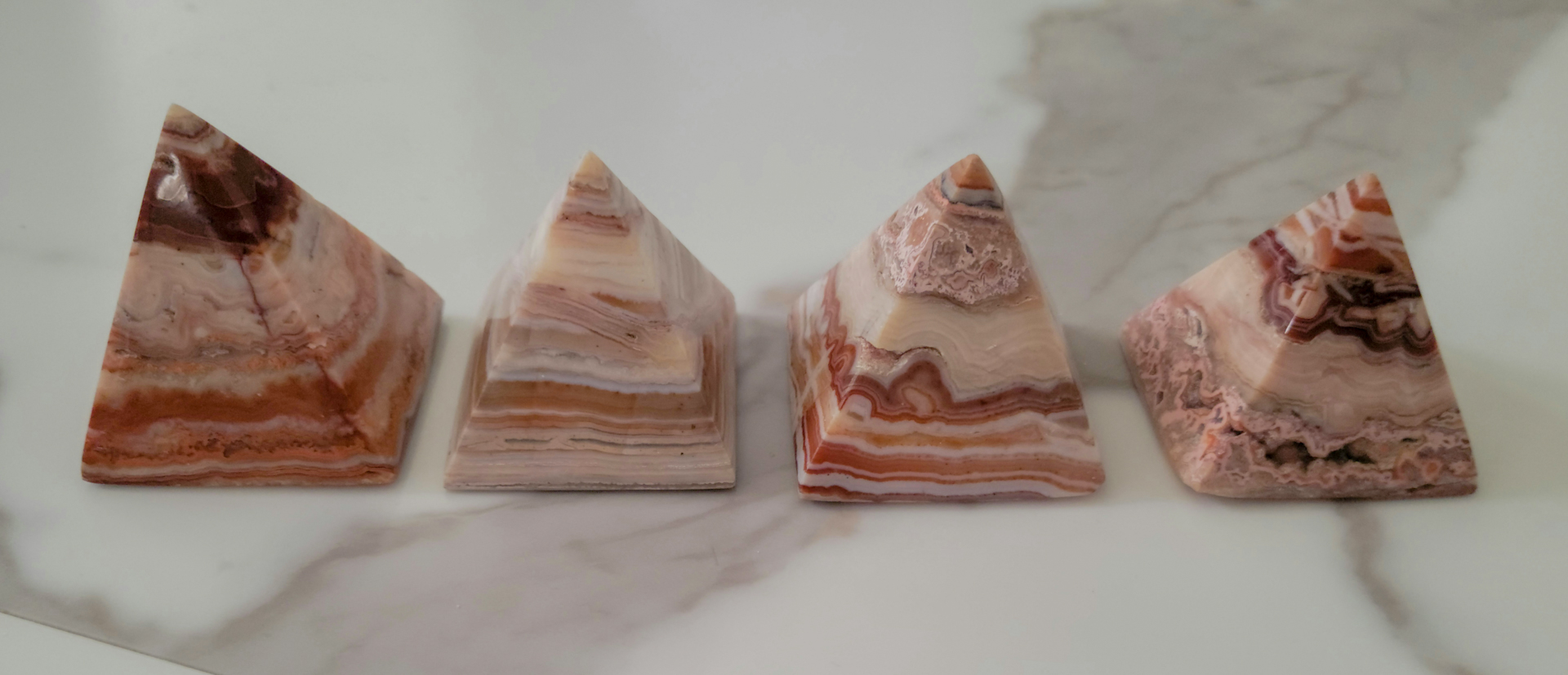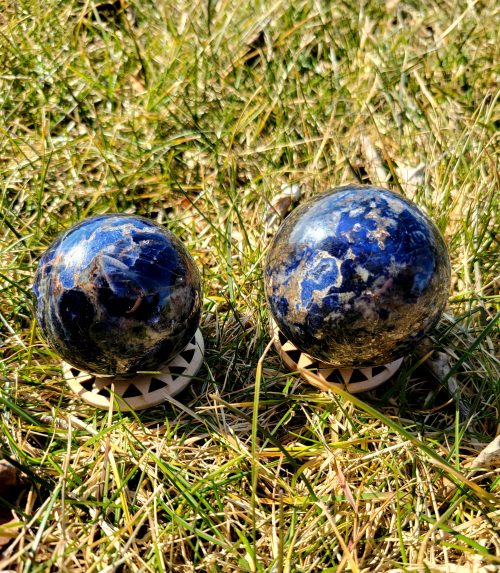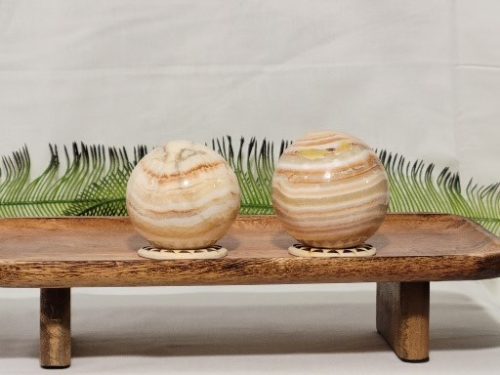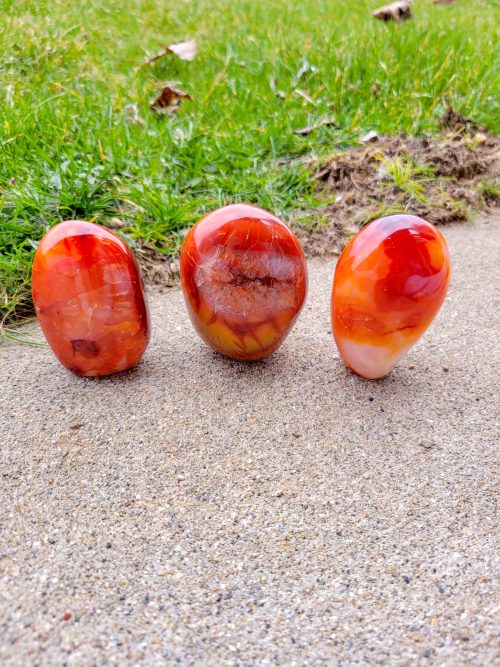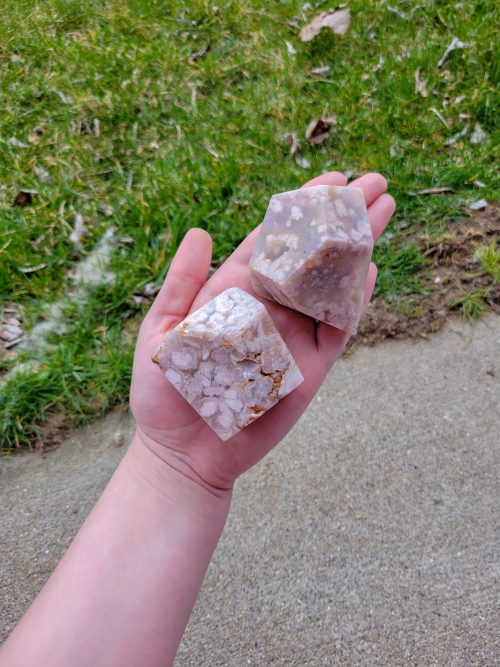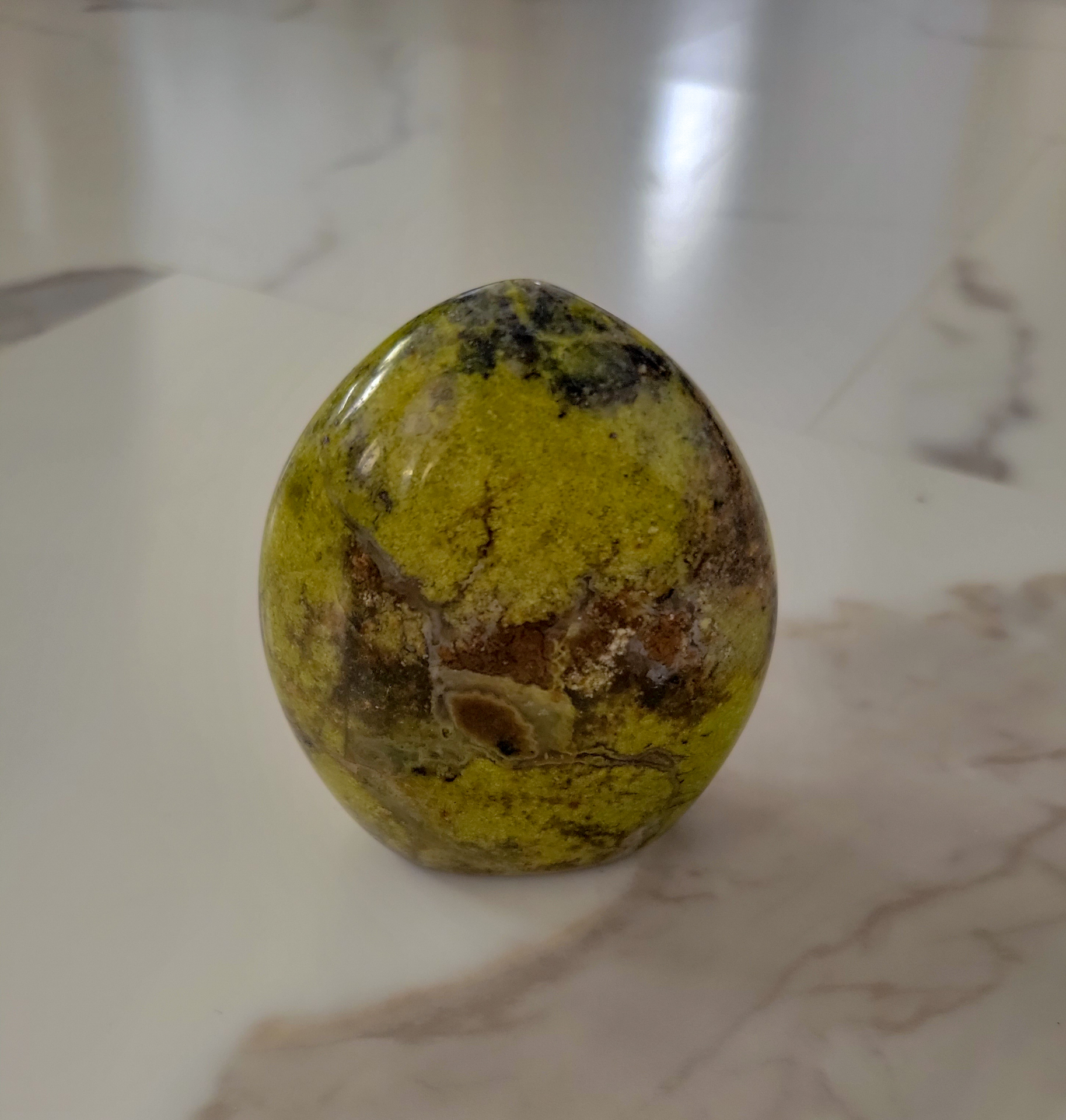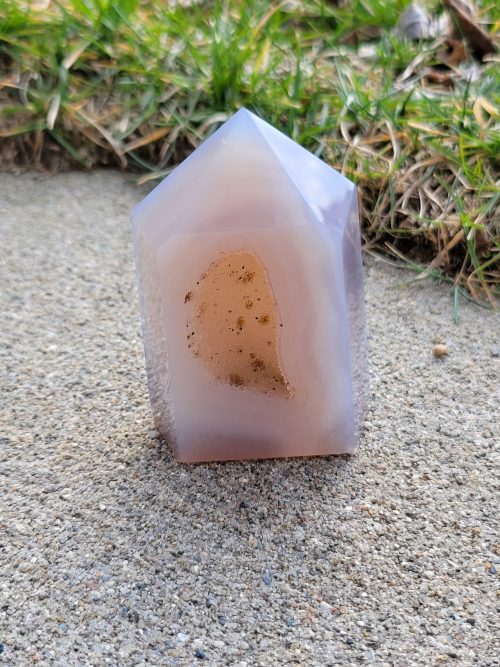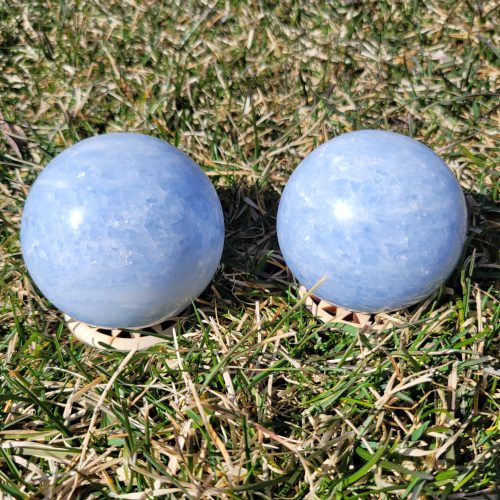-
45mm Lapis lazuli forms near igneous interferances where limestone or marble has been altered by contact metamorphism or hydrothermal metamorphism. In these rocks, lazurite replaces portions of the host rock and often develops within certain bands or layers which can include other minerals such as pyrite and white calcite. Lapis Lazuli is mostly found in Afghanistan but can also be found in Chile, Russia, Canada, Argentina, Pakistan, and the US. Within the US, these stones can be found in Colorado, California, and Arizona. ***Due to natural variations in stones, appearance will vary***
-
5cm Wide Fluorite is composed of fluorine and calcium and is formed in hydrothermal veins in the Earth's crust. This mineral can be found in all colors of the rainbow with different hues. The different colors in Fluorite are caused by impurities within the mineral. The deeper colors are found in well-formed crystals. Fluorite was originally discovered in Illinois in 1842 but is no longer mined in the US. It can be found in China, South Africa, Mongolia, France, and Russia. ***Due to natural variations in stones, the appearance will vary***
-
7.5cm Tall Ocean jasper is a rare and colorful material exclusively from Madagascar. It is described as a variety of Orbicular Jasper due to its orb-like inclusions. Ocean jasper is a name for what is known to be a spherulitic chalcedony which is a cryptocrystalline variety of quartz. Cryptocrystalline is a term that means its crystals are too small to be seen with the naked eye. ***Due to natural variations in stones, appearance will vary***
-
5.5cm x 4cm x 4.5cm Agate is a translucent form of microcrystalline quartz. These crystals form inside of igneous rocks over a long period of time and get their banding from years of siliceous groundwater building up in the cavities of these rocks. What makes this mineral so beautiful and unique is that the color variations and banding patterns are completely dependent on the environmental factors around them. This makes it so that every formation is different and there are no two formations that are the same! ***Due to natural variations in stones, the appearance will vary***
-
10cm Tall Rhodonite is a silicate mineral usually found in metamorphic rocks that are known to have other manganese minerals in them. The manganese is how Rhodonite gets its color. These beautiful minerals can be found in Argentina, Australia, Brazil, Canada, and many other places. ***Due to natural variations in stones, the appearance will vary***
-
8cm Tall Mexican Agate is a form of Crazy Lace Agate found in Mexico. These crystals form inside of igneous rocks over a long period of time and get their banding from years of siliceous groundwater building up in the cavities of these rocks. What makes this mineral so beautiful and unique is that the color variations and banding patterns are completely dependent on the environmental factors around them. This makes it so that every formation is different and there are no two formations that are the same! ***Due to natural variations in stones, appearance will vary***
-
4 x 2 x 6cm Celestite is a mineral consisting of strontium sulfate. The mineral is named for its periwinkle blue color. Celestite and the carbonate mineral strontianite are the main sources of the element strontium which is commonly used in fireworks and in various metal alloys. This mineral is found in Madagascar and Sicily, Italy. ***Due to natural variations in stones, appearance will vary***
-
8 x 2 x 7cm Rose Quartz is an anhedral crystal. It is found in the cores of pegmatites and gets its color from microscopic inclusions of a pink variety of the mineral dumortierite . Rose Quartz is naturally a pink hue but can have more hues of grey/purple or red. This mineral Earth's can be found in many places including South Africa, Madagascar, and Brazil. ***Due to natural variations in stones, the appearance will vary***
-
8 x 2 x 8cm Septarian concretions are concretions containing cavities or cracks, called septaria. The septaria are the calcite (yellow) filled cracks at the center of the rock, indicating where the center of the concretions have shrunk, possibly during dehydration during its transformative journey over a long period of time. Septarian can be found mostly in the Gulf of Mexico and Madagascar. ***Due to natural variations in stones, appearance will vary***
-
11cm Tall Apatite is formed under sedimentary rocks found in marine environments. In this environment, phosphatic organic debris (such as bones, teeth, scales, and fecal material) mineralizes to form these crystals. These crystals vary from green to blue color. ***Due to natural variations in stones, the appearance will vary***
-
55mm Septarian concretions are concretions containing cavities or cracks, called septaria. The septaria are the calcite (yellow) filled cracks at the center of the rock, indicating where the center of the concretions have shrunk, possibly during dehydration during its transformative journey over a long period of time. Septarian can be found mostly in the Gulf of Mexico and Madagascar. ***Due to natural variations in stones, appearance will vary***
-
9cm - 10cm Tall Amazonite is a type of feldspar that gets its name from the Amazon River. Geologists once thought the color came from the oxides that come off of copper. In recent studies, geologists suggest this stone gets its color from the lead and water contents that are found within its contents. Originally found in Brazil, these beautiful rocks can also be found in Madagascar. There have also been findings of this crystal in Colorado, United States. ***Due to natural variations in stones, the appearance will vary***
-
7.5cm Wide Ocean jasper is a rare and colorful material exclusively from Madagascar. It is described as a variety of Orbicular Jasper due to its orb-like inclusions. Ocean jasper is a name for what is known to be a spherulitic chalcedony which is a cryptocrystalline variety of quartz. Cryptocrystalline is a term that means its crystals are too small to be seen with the naked eye. ***Due to natural variations in stones, appearance will vary***
-
9cm Tall Septarian concretions are concretions containing cavities or cracks, called septaria. The septaria are the calcite (yellow) filled cracks at the center of the rock, indicating where the center of the concretions have shrunk, possibly during dehydration during its transformative journey over a long period of time. Septarian can be found mostly in the Gulf of Mexico and Madagascar. ***Due to natural variations in stones, appearance will vary***
-
6cm x 3.5cm x 2.5cm Agate is a translucent form of microcrystalline quartz. These crystals form inside of igneous rocks over a long period of time and get their banding from years of siliceous groundwater building up in the cavities of these rocks. What makes this mineral so beautiful and unique is that the color variations and banding patterns are completely dependent on the environmental factors around them. This makes it so that every formation is different and there are no two formations that are the same! ***Due to natural variations in stones, the appearance will vary***
-
10cm Tall Moss agate is a semi-precious stone. It is a variety of Chalcedony and it formed from silicon dioxide. The field of this stone is a milky white or clear quartz with blue and green inclusions that form as a result of oxides in the mineral. The dendritic inclusions are mainly made from manganese or iron that grow into patterns to give it the moss look. ***Due to natural variations in stones, the appearance will vary***
-
9cm Tall Flower agate gets its name from the flower-like formations within the crystal's body. These crystals are volcanic rocks that are mainly composed of chalcedony and quartz. These crystals can vary in color; from pink to a dark grey/purple. Recently discovered in Madagascar, these crystals are believed to go back to 2000 BC. ***Due to natural variations in stones, the appearance will vary***
-
8 x 3 x 8cm Green Opal is a type of common opal that ranges in color from a pale to dark green. It's one of the easiest Opals to find and can be found in 6 continents. Most of these specimens have come from Australia, Brazil, USA, Mexico, and Peru. ***Due to natural variations in stones, the appearance will vary***
-
45mm - 50mm Carnelian is a part of the Chalcedony family. It is formed when two silica minerals with different crystal structures grow together such as quartz and moganite. The firey orange and red colors come from iron oxides in the mineral. Carnelian can be found in Brazil, India, and Uruguay. ***Due to natural variations in stones, the appearance will vary***
-
5cm x 4cm x 9cm Flower agate gets its name from the flower-like formations within the crystal's body. These crystals are volcanic rocks that are mainly composed of chalcedony and quartz. These crystals can vary in color; from pink to a dark grey/purple. Recently discovered in Madagascar, these crystals are believed to go back to 2000 BC. ***Due to natural variations in stones, the appearance will vary***
-
55mm Rhodonite is a silicate mineral usually found in metamorphic rocks that are known to have other manganese minerals in them. The manganese is how Rhodonite gets its color. These beautiful minerals can be found in Argentina, Australia, Brazil, Canada, and many other places. ***Due to natural variations in stones, the appearance will vary***
-
60mm Howlite was originally discovered in Canada by a geologist named Henry How which is where its name comes from. Howlite is formed in evaporate deposits with other borate and evaporate minerals. The outside of the mineral is not pleasant to the eye and is said to look like a head of cauliflower. However, when that is taken off, this beautiful mineral is found inside! This mineral is mainly found in Canada and the USA. ***Due to natural variations in stones, the appearance will vary***
-
5.5cm x 4.5cm x 2cm Agate is a translucent form of microcrystalline quartz. These crystals form inside of igneous rocks over a long period of time and get their banding from years of siliceous groundwater building up in the cavities of these rocks. What makes this mineral so beautiful and unique is that the color variations and banding patterns are completely dependent on the environmental factors around them. This makes it so that every formation is different and there are no two formations that are the same! ***Due to natural variations in stones, the appearance will vary***
-
10.5cm Long Fluorite is composed of fluorine and calcium and is formed in hydrothermal veins in the Earth's crust. This mineral can be found in all colors of the rainbow with different hues. The different colors in Fluorite are caused by impurities within the mineral. The deeper colors are found in well-formed crystals. Fluorite was originally discovered in Illinois in 1842 but is no longer mined in the US. It can be found in China, South Africa, Mongolia, France, and Russia. ***Due to natural variations in stones, the appearance will vary***
-
11 x 2 x 11cm Black moonstone is a silicate gemstone and is famous for its shimmering effect when moved in sunlight. It is believed that these stones resemble the moon when they show their shimmer. Most of the black moonstones have swirls and lines of tan, gray, and peach. Moonstones come in a variety of colors; black, pink, green, white, brown, and grey. This mineral was originally discovered in Madagascar but can also be found in Armenia, Australia, Mexico, and many other countries. ***Due to natural variations in stones, the appearance will vary***
-
60mm Rhodonite is a silicate mineral usually found in metamorphic rocks that are known to have other manganese minerals in them. The manganese is how Rhodonite gets its color. These beautiful minerals can be found in Argentina, Australia, Brazil, Canada, and many other places. ***Due to natural variations in stones, the appearance will vary***
-
9cm Wide Calcite is a rock-forming mineral that is found throughout the world in sedimentary, metamorphic, and igneous rocks. The blue color comes from the calcium carbonate inclusions within this mineral. Blue calcite can be found in many places around the world but mostly in Mexico, The United States, Britain, and Iceland. ***Due to natural variations in stones, appearance will vary***
-
4 x 4 x 5cm Agate is a translucent form of microcrystalline quartz. These crystals form inside of igneous rocks over a long period of time and get their banding from years of siliceous groundwater building up in the cavities of these rocks. What makes this mineral so beautiful and unique is that the color variations and banding patterns are completely dependent on the environmental factors around them. This makes it so that every formation is different and there are no two formations that are the same! ***Due to natural variations in stones, the appearance will vary***
-
60mm Sodalite is a rare mineral formed inside igneous rocks crystalized as a result of sodium-rich magma. The blue color comes from the rock that Sodalite is formed in; nepheline syenite, trachyte, and phonolite. Although the sodalite-bearing rock is rare, it can most commonly be found in the US, Canada, and Africa. ***Due to natural variations in stones, the appearance will vary***
-
60mm - 70mm Calcite is a mineral when originally formed is colorless and opaque and can come in many different forms of translucency. It gets its beautiful colors and banding from impurities in the rocks the specimen is formed in. Calcite gets its name from the water within the mineral being rich in calcium. This soft mineral can be found all over the world; mainly in shallow marine settings such as hydrothermal veins and hot spring deposits. Many marine life species, such as crabs and coral, rely on calcite to form their shells. ***Due to natural variations in stones, the appearance will vary***
-
5cm x 4cm x 7.5cm Carnelian is a part of the Chalcedony family. It is formed when two silica minerals with different crystal structures grow together such as quartz and moganite. The firey orange and red colors come from iron oxides in the mineral. Carnelian can be found in Brazil, India, and Uruguay. ***Due to natural variations in stones, the appearance will vary***
-
6cm Wide Flower agate gets its name from the flower-like formations within the crystal's body. These crystals are volcanic rocks that are mainly composed of chalcedony and quartz. These crystals can vary in color; from pink to a dark grey/purple. Recently discovered in Madagascar, these crystals are believed to go back to 2000 BC. ***Due to natural variations in stones, the appearance will vary***
-
6cm x 6.5cm x 1.5cm Agate is a translucent form of microcrystalline quartz. These crystals form inside of igneous rocks over a long period of time and get their banding from years of siliceous groundwater building up in the cavities of these rocks. What makes this mineral so beautiful and unique is that the color variations and banding patterns are completely dependent on the environmental factors around them. This makes it so that every formation is different and there are no two formations that are the same! ***Due to natural variations in stones, the appearance will vary***
-
9 x 3 x 10cm Green Opal is a type of common opal that ranges in color from a pale to dark green. It's one of the easiest Opals to find and can be found in 6 continents. Most of these specimens have come from Australia, Brazil, USA, Mexico, and Peru. ***Due to natural variations in stones, the appearance will vary***
-
5.5cm x 3.5cm x 8cm Agate is a translucent form of microcrystalline quartz. These crystals form inside of igneous rocks over a long period of time and get their banding from years of siliceous groundwater building up in the cavities of these rocks. What makes this mineral so beautiful and unique is that the color variations and banding patterns are completely dependent on the environmental factors around them. This makes it so that every formation is different and there are no two formations that are the same! ***Due to natural variations in stones, the appearance will vary***
-
65mm Calcite is a rock-forming mineral that is found throughout the world in sedimentary, metamorphic, and igneous rocks. The blue color comes from the calcium carbonate inclusions within this mineral. Blue calcite can be found in many places around the world but mostly in Mexico, The United States, Britain, and Iceland. ***Due to natural variations in stones, appearance will vary***

